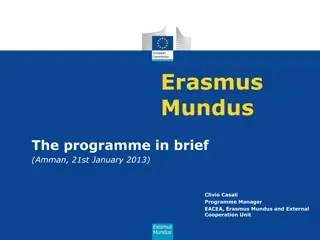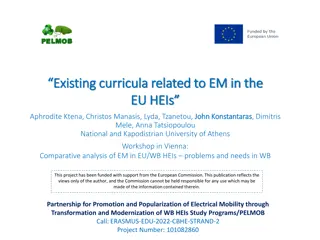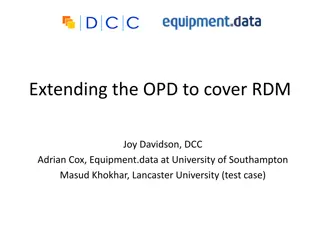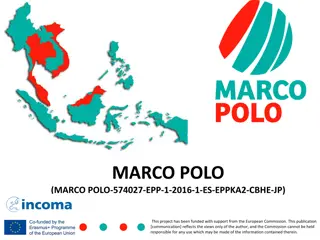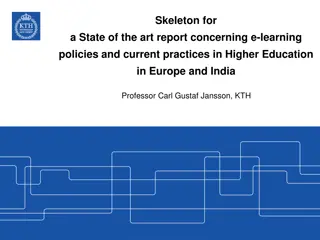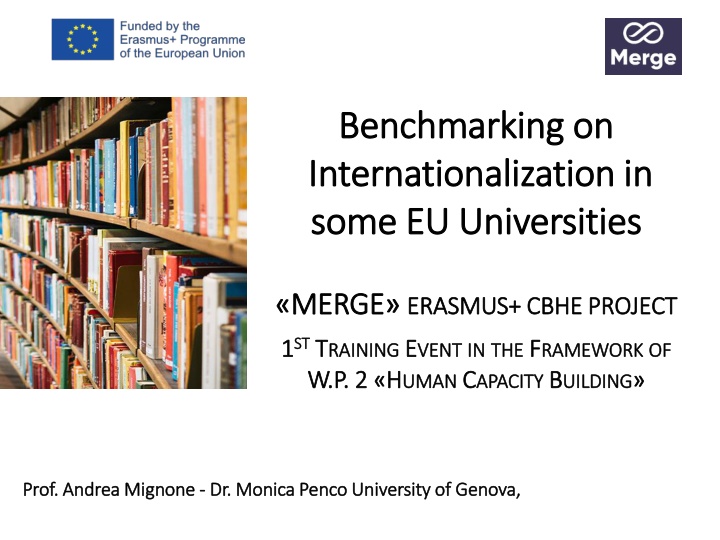
Benchmarking Approach for Internationalization in EU Universities
Explore the significance of benchmarking in enhancing the internationalization of higher education systems across EU universities. Discover the rationale behind cross-country comparisons and how benchmarking contributes to the improvement of higher education performance.
Download Presentation

Please find below an Image/Link to download the presentation.
The content on the website is provided AS IS for your information and personal use only. It may not be sold, licensed, or shared on other websites without obtaining consent from the author. If you encounter any issues during the download, it is possible that the publisher has removed the file from their server.
You are allowed to download the files provided on this website for personal or commercial use, subject to the condition that they are used lawfully. All files are the property of their respective owners.
The content on the website is provided AS IS for your information and personal use only. It may not be sold, licensed, or shared on other websites without obtaining consent from the author.
E N D
Presentation Transcript
Benchmarking on Benchmarking on Internationalization in Internationalization in some EU Universities some EU Universities MERGE MERGE ERASMUS+ CBHE PROJECT ERASMUS+ CBHE PROJECT 1 1ST STT TRAINING RAINING E EVENT W.P. 2 H W.P. 2 HUMAN THE F FRAMEWORK RAMEWORK OF APACITY B BUILDING UILDING VENT IN IN THE UMANC CAPACITY OF Prof. Andrea Prof. Andrea Mignone Mignone - - Dr. Dr. Monica Penco University of Monica Penco University of Genova Genova, ,
Content Content - Benchmarking as a strategy in order to plan (WHAT TO DO) - Importance of internationalization (WHY TO DO) - Different approaches according to benchmarking results of two main researches (HOW TO DO) - AEuropean project that involved HEI in 6 European countries - A 2020 EUA (European University Association) survey that involved all the European countries https://eua.eu/downloads/publications/eua%20international%20partnerships%20survey.pdf 2
Rationale (1) Many internationalization of their higher education systems and would like to learn how good their systems are performing in comparison to others. Cross-country comparisons through the benchmarking of different higher education systems will enable countries to learn more about their strengths and weaknesses and provide a laboratory for others by identifying what works in higher education. Benchmarking higher education system performance will contribute towards improvement across different higher education systems. Benchmarking as the process of comparing higher education systems, including policies, practices and outcomes, to enable countries to identify strengths and weaknesses in each higher education system; learn from each other; and improve the performance of their higher education systems. countries share common concerns about the 3
Rationale (2) The benchmarking exercise should be based on a theoretically-justified conceptual model: The benchmarking should internationalization s strategies; The benchmarking should recognize that there are many dimensions of internationalization and the importance placed by each country on different dimensions may differ; The benchmarking should be context aware, i.e. acknowledge the economic, social and cultural context in which higher education operates; The benchmarking should recognize that countries have different system features, constraints, challenges and policy priorities that need to be taken into account to enable meaningful comparisons. reflect the complex of
The relevance of benchmarking approach The relevance of benchmarking approach The benchmarking approach goes beyond metrics to focus also on policy and practice benchmarking in order to tell the story behind internationalization of higher education systems. It will enable cross-country comparisons and peer learning to support the developmental dimension of internationalization measurement and management. The proposed benchmarking approach to enhance higher education system performance acknowledges the economic, social and cultural context of higher education.
Benchmarking approach Benchmarking approach The benchmarking approach is a tool for developing higher education systems and it addresses the strong demand for the comparative assessment of higher education systems. The benchmarking will raise the visibility of the importance of higher education for developing our economies and societies
Types of the benchmarking used in research Types of the benchmarking used in research Three kinds of benchmarking: Metric benchmarking: Metric benchmarking is used to present information on internationalization processes so that countries can identify the strengths and weaknesses within their own higher education systems and compare their performance against other countries. Practice benchmarking: Information on higher education practices (or activities) will be presented to enable the comparison of higher education system internationalization and a better understanding of the reasons behind the performance. Policy benchmarking: Government policy is a key driver of the internationalization of higher education systems. The comparison of policies between different systems has the potential to lead to a better understanding of the linkages between policy and outcomes. INTERNAL and EXTERNAL BENCHMARKING
The goals of benchmarking activity The goals of benchmarking activity Benchmarking the internationalization of higher education systems through multi-dimensional measures will: Enable comparisons across agreed dimensions of internationalization of higher education systems Identify strengths and weaknesses of each country s higher education system Provide a basis for peer learning Provide a basis for developing strategies for improvements in the performance of higher education systems. IT AIMS AT DESCRIBING, COMPARING, IMPROVING
The relevance of internationalization The relevance of internationalization The intense of competition among universities and colleges can be attributed to globalization; universities and colleges compete with each other not only on the local level but internationally. Moreover, systems and policies in higher education institutions (HEIs) are being transformed by globalization. Because of this, universities started adopting strategies for internationalization. Therefore, the theme of internationalization in higher education started gaining attention by scholars and policy makers in the last decades of twentieth century. At the moment Internationalization is considered to be one of the major aspects to be dealt with higher education institutions. As a consequence, prior knowledge on the Higher Education Institutions internationalization current status and the identification of the core areas of intervention and development is essential in order to structure valid internationalization and marketing strategies.
European visions of International European visions of International Universities cooperation Universities cooperation The Lisbon European Council (March 2000) reaffirmed the following challenge before the European Union: to become the most competitive, sustainable and dynamic knowledge-based economic region of the world by the year 2010 . Through the Framework Programme (2002/06 2007/2013 2014/2020 2021/27), to contribute towards the creation of a European Research Area, which is considered as a central component of the process of developing a knowledge-based economy and society in the EU by promoting innovation, competitiveness and employment, sustainable economic growth and social cohesion The EU s decision to establish a European Higher Education Area by the year 2010. The Intergovernmental decision (Bologna and Prague) and the resulting Declaration to establish through the European Higher Education Area, a Higher Education system that is Readable , Compatible and Comparable .
Universities Ranking as Benchmarking Universities all over the world are seeking to internationalize their business . They face a competitive environment that increasingly requires them to operate very strategically towards multiple, sometimes conflicting, goals, resulting in competition, as well as collaboration, on a global scale. An increasing number of university league tables are now published, with higher education institutions (HEIs) anxious to enter the ranks of the top 50, top 100 or top something else. Some of these league tables aim to capture the degree of internationalization of the institutions, yet in this students/staff/partners, less attention seems to have been paid to the social viability of internationalising a university s community. We call for the inclusion of an intercultural component, which takes into account the social complexity of truly internationalised university communities. race for international
Universities Ranking as Benchmarking A number of organizations include internationalization in their benchmarking of worldwide universities, the most well-known of which are Times Higher https://www.timeshighereducation.com/world-university- rankings/2021/world- ranking#!/page/0/length/25/sort_by/rank/sort_order/asc/cols/stats, QS World ranking, ARWU of Shanghai University and U-Multirank. The parameters that these organisations use to measure internationalisation are shown in Table 1 and, as can be seen, they are all exclusively structural in nature. They focus on different countable measures, most notably national composition of students and staff as well as in the numbers engaged in international movement and research. Clearly there are significant differences between the systems in the number, range and precise definitions of the parameters used. Education (THE) rankings
Table 1 Parameters for ranking internationalization Parameters THE QS U-Multirank ARWU International students ratio x x International staff ratio x x x International diversity (ratio of home vs. international students) x Students mobility x x International students support x x International joint pubblications x x x x Staff reputation x x x x Papers indexed x x Quality of education x x
Content Content Aim: to analyze the results of a benchmarking carried out at European level in order to evaluate possible experiences that can be borrowed both for institutional strategies and for good organizational practices. The Report is aimed at comparing some experiences of university structures dedicated to internationalization, especially at E.U. level. IROs of the following universities have been examined: Aalen (D), Antwerp and Leiden (The Netherlands), Bath (GB), Cyprus, Grenoble (F), Luxembourg, Stockholm (S). The benchmarking will be useful for the comparison with the benchmarking of IROs in the PCUs (W.P. 1, point 1.3), in order to select some good practices and administrative structures. The 6 main dimensions analyzed were the following: Facts and figures; International structures and models governance; Academic offer and training for academic and non-academic staff; Student support services; International promotion and visibility; Marketing and Communication. 14
The target (1) The target (1) The target was to get a picture of how each university works regarding the number of students, grants, programmes, incoming and outgoing mobility, international agreements and network participation, research units and scientific publications, among other indicators. With IROs, the target was to gather institutional and management information, units and staff involved in international operations, internationalization level of the infrastructures and internationalization reflection on institutional aspects. Regarding the academic offer and training the objective was to collect information in all types of training short courses, specific training in internationalization and transversal topics, English training and communication skills, staff and teaching mobility. With Student Services the aim was to collect information about the support services, availability of information in the Institutions website, first contact with the international student and structures dealing with prospective international students, pre-arrival support provided and activities organized. Regarding International Visibility, the target was to gather information about the services, programmes and activities that trigger each institution international promotion. Additional information has been acquired through publications of EUA; websites of universities
Suggestions Suggestions Some countries are not fully exploring the benefits of internationalization. Countries that attract international students are tapping the global pool for talent. Some countries have even eased their immigration policies to encourage the temporary or permanent immigration of international students. On the other hand, other countries are curbing international student numbers as a result of more strict immigration policies, as a backlash to significant increases in migratory flows. Countries that charge international students the full cost of education also reap significant economic benefits. For this reason, several countries have policies to attract international students on a revenue-generating or at least cost-recovery basis. Some countries have less success in attracting international students and researchers which hinders their competitiveness in the search for talent and in the economic impact of their higher education system. It also diminishes the exposure of home students to international students, and thus their capacity to operate in global environments later on. It is sometimes difficult for students to assess the quality of cross-border higher education. It is often still too difficult for students and other stakeholders to easily access the information they need to assess the quality of cross- border provision or to understand the process of quality assurance that foreign providers or programmes undergo.
Results. Different visions (1) Results. Different visions (1) Benchmarking has outlined different visions of internationalization of universities: Technocratic: development of learning at distance, networks cooperation, Life Long Learning; Professional: research, rankings, etc.; Academic: mobility of students and professors; Bologna process and ECTS; double degrees, etc.
Results. Different visions (2) Results. Different visions (2) Moreover, internationalization can be seen from two different points of view: cooperation and competition. The first one relates to the world of mobility programmes, the institutional level of the universities; The second one relates to the world of marketing, rankings, promotion abroad. There are also some activities in-between: certifications, quality assessment, human resources skills. There is not a perfect model of international relations management within universities. In the future more and more decentralization will be reached, giving more autonomy to the different structures of the university.
Objectives outlined by benchmarking Objectives outlined by benchmarking In general, the internationalization strategy and the activities of IROs are oriented to: Promotion of staff and student mobility (in and out); Participation to Erasmus + programs; Information and communication on mobility opportunities; Common courses and joint or double degrees; Agreements with partners universities; International partnership; Financing some students to participate in an international summer school abroad; Virtual campus; International research; Improvement of university s ranking. In some cases, we noted: the involvement in this activity of Alumni and students organizations or associations; the role of national Embassies in foreign countries in promoting universities; the involvement of special agents representatives of universities in communication s activities abroad
General overview of benchmarking General overview of benchmarking Main findings can be considered from the benchmarking: About one-third of investigated universities have an international student population above 15% of total students enrolled. All universities have an internationalization strategy in place (60%), intend to develop one (10%) or have considered internationalization in other strategies (30%). All universities confirm that strategy has had a positive impact on their institution s internationalization, development of partnership, outgoing students mobility, attraction of international students and development of staff mobility opportunities. The internationalization strategy of universities would have a positive impact on funding opportunities but also on national bodies and university community. With reference to the national contribution to internationalization, there are three positive factors: increased funding, development of a national strategy for internationalization and relaxing the bureaucratic procedures and regulations in place (e.g. Visa). particularly with regards to
Results. Governance (1) Results. Governance (1) However, the IRO is not always the reference for internationalization at the university: many institutions split responsibilities between centralized (central administration) and decentralized (faculties/departments) levels. Centralized and decentralized models. In a centralized model, all agreements are managed by the central IRO. In a decentralized faculty/department/school has its own International Office. As we can explain, all depends on the policy of the institution in other words, the Rector s and governing bodies decisions. model, every
Different organizations models (1) Different organization s models (1) Regarding the specific models of international relations management, the detailed description of the several models in Europe is as follows: Vice-Rector for International Relations, who is a member of the University Board, coordinates international activities. University Board can initiate specific international activities. Schools and Departments can have high level of independence and can carry out their own international activities and conclude own (school-specific) agreements. Management board, Vice-Presidents for different areas, Different Areas Coordinators - Staff/Workers. In recent years there is the tendency to decentralize the International Relations Offices (IROs) activities and a bottom-up approach was the top factor of development. The need for internationalization was institutional need for quality assurance system development. General international strategy is defined by the management board and goals are realized by the IROs from the International office and academic staff for research.
Different organizations models (2) Different organization s models (2) The Vice Rector is the delegate to international relations. In some cases, there are more delegates with specific functions: e.g. PhD, doctorates, research, students mobility, international cooperation, third mission, etc. In some cases, there are offices for international relations inside Departments In some cases, the international activity is allocated in a specific staff of the Rector In general, IROs are dependent directly by General Director of University In some cases, there is only an independent area for internationalization, in other internationalization activities is articulated in many areas. cases the complex of
Human Resources Human Resources It is important for people working in IROs offices to possess a number of attributes that will make a difference: Personality: open-minded, committed on the objectives of the plan Skills: knowledge of languages, IT skills, managerial skills, problem-solving skills, crisis management skills (e.g. in pandemic Covid19 crisis) Continuous training professional and
Useful warnings from the cases examined Useful warnings from the cases examined Relevance of the national public policies for a successful internationalization of the university system in the country (especially for international research and networks). Additional funding for universities more oriented towards internationalization. Relevance of the socioeconomic and cultural environment in which the university is embedded. Need for continuous implementation and adaptation of the objectives and goals. Incentives or cost reductions for internationalization activities of staff and students must be foreseen. Improvement of the logistics offer (structures and services) for international mobility (ingoing). Strong involvement of stakeholders, especially civil society, also to obtain financing.
Exercise Taking into account the benchmarking s slides and the situation of your University (University of .), which model do you think is applicable for the internationalization process with respect to: Internal governance of university Type of internationalization Objectives Actions Tools Organization models of IROs





